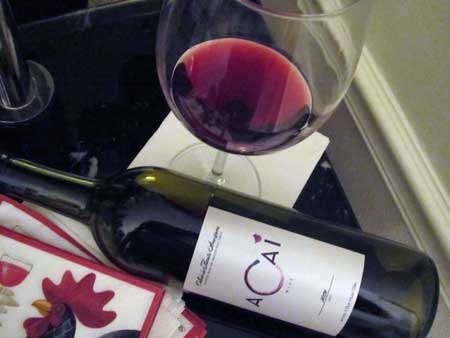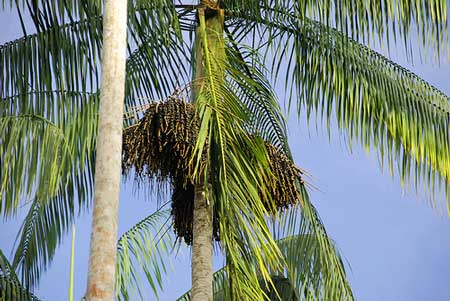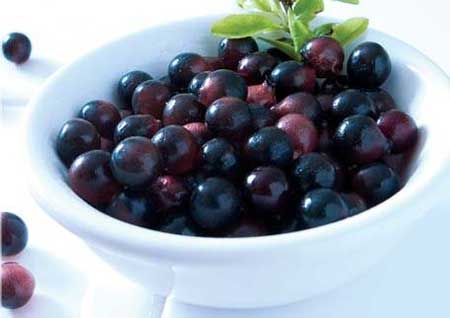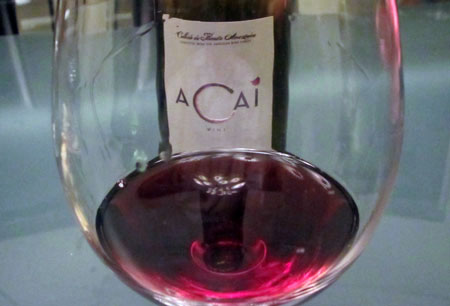Sniffing and Swirling: It’s the 1st Premium Açaí Wine
I’ve had more than a few trips to Brazil. So many, that I sometimes default to the local spelling of Brasil. I’ve savored the scent of a tropical night breeze on the Brasilian coast while imbibing the national drink of the country: a Caipirinha. It’s usually made with local cachaça rum, sugar and lime. However, on my last trip, I ended up for a wild night at a cachaçaria in Forteleza in the northern part of the country close to the Amazon. There, the Caipirinhas were not made with lime, but with the strange dark black-purple fruit of the açaí palm, that had a rich blueberry-like taste to it.
Fast forward two years, and I’m sitting here in my Texas Hill Country cottage with my large format wine glasses and wine evaluation sheets while I’m looking out at the hills north to Fredericksburg. After the pour, it’s obvious what I’ve got in the glass is a medium-bodied, red wine, and a serious red wine at that. It’s visually clear and bright and exhibits a brilliant red -purple color. The dominant aroma and flavors are those of blueberry, but combined with a red fruit component, something like sour cherry. Later, after reading the back label of the bottle, it became obvious to me what it was. The red fruit descriptor that I was searching for was pomegranate.
What I was tasting was was a bottle of commercially produced premium Açaí (pronounced ah – SIGH – ee) wine made by two “Texas boys”, Mike Sipowicz and Steve Talcott, both. Mike is the winemaker, Steve is the açaí fruit specialist, he is actually Dr. Steve Talcott, but as he readily admitted, “In this operation, doctor of what? I am not exactly sure.” However, one thing that each agree on is that they are the Co-Founders of Acai Wine, LLC.
Mike seemed pleased after reading my tasting notes. He said, “I’ve been working on the formulation, running numerous pilot fermentations, for the past year. But, it’s actually Steve’s brain child. He’s been looking into food products that contain açai, the Brazilian ‘super fruit’ and has been involved in the startup of numerous fruit beverage operations.”
More on the Nose
There was also something else that I detected on the nose of the açaí wine, a non–fruit component more pervasive on the first pour than on the second about 3 hours later. It was originally like mint or eucalyptus, but at times reminiscent of anise. But, on the second pour, this sensation seemed to have been replaced with aromatic woody note, maybe sandalwood.
Another interesting characteristic was a slight prickle detectable on the palate midway through the tasting profile (that wine geeks oft call the mid-palate). It could be the play of natural acidity of the wine or an effect of s slight frizzante (residual carbonation), although I did not visually see signs bubbles.
When I asked about their new product, Mike said, “We’ve recently completed an initial bottling run and are currently able to ship within Texas and as well as into numerous other states. We are in the process of expanding our distribution with a goal of national reach.
A One of A Kind Product
I asked him if anyone else is making açaí wine. Mike responded, “Well, the answer is simple…No. We are the first and currently the only makers of this type of product.” However, it was Steve was the first to indicate the reason why this was the case.
Steve said, “Mike may disagree with me, but I think the hardest part of making açaí wine is getting the actual açai pulp processed and into a recognizable wine format, you know, crystal clear. We do all of our own açaí pulp processing, and this presents unique challenges not observed with any other style of wine. It has taken us many years of work to be able to create this wine from start to finish.”
Later Mike confirmed,”The fruit pulp, originating from the Amazon Rain Forest, and is EXTREMELY difficult to process and turn into wine. But, we know how to do it and cost effectively.”
Steve’s been focused on the scientific and research issues regarding açaí fruit and the mechanics of incorporating it into a food and beverage products. He has been interviewed by ABC News on the facts that surround this super fruit. Click here to see his interview on an ABC Nightline News segment on Açaí, the Brazilian superfruit that packs a wallop of antioxidants.
I asked Steve about the antioxidant power of ace wine. This is a natural question if you surf the Internet. There are claims galore. However, he said, “I would really rather not get into antioxidant claims with açaí wine. We make no antioxidant claims, just that the wine is made from 100% açaí fruit, sourced exclusively out of Brazil.”
The Finish
Lastly, another aspect of the açaí tasting experience that I identified was a particularly good one for a wine. The flavor of the açaí wine seemed to linger on the palate for some time after tasting ended. It was a particularly long finish for a medium bodied red wine. It seemed to go on forever, certainly much longer than five minutes, maybe ten or more.
Where to Find it?
Check out their Acai Wine website for details on how the wine is made, how it tastes and how to buy it from their virtual storefront. They offer two styles açaí wine: Seco (dry) and Doce (sweet).
The Future
Mike said, “On the winemaking side that it is one of the most challenging wines that I have made. Syrah tends to go sulfidic during fermentation more than other varieties I have found. To make a stellar Zin, you have harvest at just the right time, knowing that it also tends to ripen unevenly. When you make wine, every variety has a unique personality. Acai fruit brought to the table a brand new set of nuances that were foreign to me along with “varietal” idiosyncrasies that I had to learn. Acai reacts counter intuitively in the winery. It was (and continues to be) a very fun learning process, a little humbling too.”
Mike continued, “We have the Acai Wine Texas sales site ready to go with probably one of the best (if not THE best) shipping and handling deals that you’re likely to find anywhere. Additionally, we can ship to Arkansas, Florida, Indiana, Louisiana, Maine, Missouri, Nevada, New Hampshire, New Mexico,North Dakota, Ohio, Oregon, Virginia, District of Colombia, West Virginia and Wyoming. California has just come on line, as well!
In closing, he said, “We are still trying to catch the attention of Whole Foods, HEB/Central Market, World Market, and the Trader Joe’s types and the like…as well as a ‘loving and caring’ distributor to bring all the pieces together.
Just a few Açai facts
Açai fruit grows on tall palm trees that are native to the Brazilian Amazon rainforest. The fruit is made into pulp and shipped to the USA.
The traditional way of making açai drinks is to blend the pulp with an equal amount of water, other fruit juices or milk.
The Açai berry is small, round, and a black-purple in color, similar in appearance but smaller than a grape.
Açaí perishes within 24 hours and was originally limited to the Amazon. However, modern refrigerated transport makes it possible to ship frozen Açaí pulp around the world, making it’s use in wine possible.
The antioxidant potency of açaí depends on the amount present in the formulation, but a typical açai pulp may range in antioxidant capacity from 30-60 micromole Trolox equivalents per mL (need to be a tenured professor to sort out these units). This can be compared to the recent Texas wine survey that found antioxidant values for Cabs ranging from 23-57 and Syrahs from 22-34. So the values are comparable.
For more on açaí, click here.







Be the first to comment